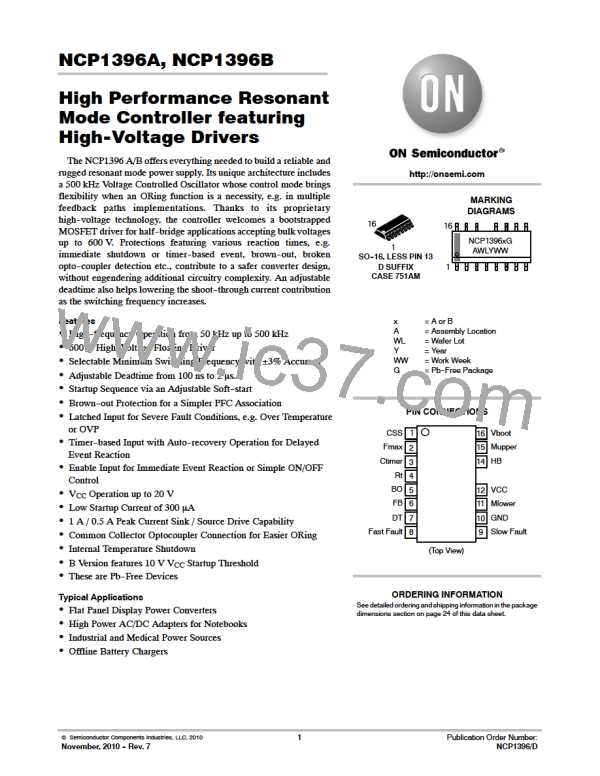NCP1396A, NCP1396B
During the discharge time, the clock comparator is high
overthe VCOleadassoonasthe output voltage hasreached
the target. If not, then the minimum switching frequency is
reached and a fault is detected on the feedback pin
(typically below 600 mV). Figure 41 depicts a typical
frequency evolution with soft-start.
and un-validates the AND gates: both outputs are low.
When the comparator goes back to the low level, duringthe
timing capacitor Ct recharge time, A and B outputs are
validated. By connecting a resistor RDT to ground, it
creates a current whose image serves to discharge the Ct
capacitor: we control the dead-time. The typical range
evolves between 100 ns (RDT = 3.5 kΩ) and 2 ms (RDT =
83.5 kΩ). Figure 43 shows the typical waveforms.
Fsw
Fmax
Soft--start Sequence
If no FB
Action
In resonant controllers, a soft-start is needed to avoid
suddenly applying the full current into the resonating
circuit. In this controller, a soft-start capacitor connects to
pin 1 and offers a smooth frequency variation upon
start-up: when the circuit starts topulse, the VCO ispushed
to the maximum switching frequency imposed by pin 2.
Then, it linearly decreases its frequency toward the
minimum frequency selected by a resistor on pin 4. Of
course, practically, the feedback loop is suppose to take
Fmin
Vss
Soft--start Duration
Figure 41. Soft--start Behavior
20.0
10.0
0
Ires
--10.0
SS
Action
--20.0
177
Target is
175
Vout
Reached
173
171
169
1.00 m
1.40 m
1.80 m
200 m
600 m
time in seconds
Figure 42. A Typical Start--up Sequence on a LLC Converter
Please note that the soft-start will be activated in the
following conditions:
- A startup sequence
- During auto-recovery burst mode
- A brown-out recovery
- A temperature shutdown recovery
The fast fault input undergoes a special treatment. Since
we want to implement skip cycle through the fast fault
input on the NCP1396A, we cannot activate the soft-start
every time the feedback pin stops the operations in low
power mode. Therefore, when the fast fault pin is released,
no soft-start occurs to offer the best skip cycle behavior.
However, it is very possible to combine skip cycle and true
fast fault input, e.g. via ORing diodes driving pin 6. In that
case, if a signal maintains the fast fault input high long
enough to bring the feedback level down (that is to say
below 0.6 V) since the output voltage starts to fall down,
then the soft-start is activated after the release of the pin.
In the B version tailored to operate from an auxiliary 12 V
power supply, the soft-start is always activated upon the
fast fault input release, whatever the feedback condition is.
http://onsemi.com
18

 ONSEMI [ ONSEMI ]
ONSEMI [ ONSEMI ]